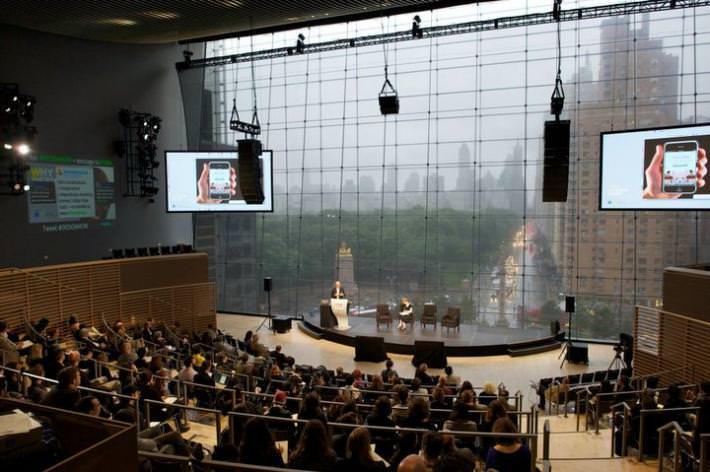The “Why Design Now?” Conference: Solving Complex Problems Through Design
Posted October 8, 2010
The “Why Design Now? Solving Global Challenges” Conference sponsored by the Cooper-Hewitt National Design Museum and GE brought together some of the world’s leaders in design to talk about how design can help solve complex problems. Some major themes emerged throughout the day that touch on many of the aspects of contemporary design practice:
1. We work collaboratively in teams.
Most of the projects shared at “Why Design Now?” came to life through a team-based approach. There was very little “I” or “me” but a lot of “we” talk throughout the day. As designers, we are finding we cannot solve these complex problems alone; we need a team. Best said by our principal designer here at ESI Design, Ed Schlossberg, “We must work in teams to do the work we do. No one is smart enough to do it alone.”
2. We co-create with our clients.
Teams go beyond just designers and studio-mates; they now integrate clients in the creative process. Chris Conley of gravitytank described today’s corporate life as EEMP: email, email, meetings and Powerpoint. Designers can break that mold. We can invitie our clients to prototype, make, and share new experiences with us.
3. We bring clarity through design.
“How can we help people make sense of information and data surrounding complex problems?” This was a question that came up several times throughout the day. Not only is data informing design, but we’re also bringing clarity to information that is difficult to understand. Lisa Strausfeld and her team at Pentagram recently collaborated with GE on data visualization tools that show home appliance energy consumption in measurements that we can easily understand, such as US dollars and gallons of gas. Lisa emphasized that we need to create more opportunities for people to not only understand their consumption of energy, but also make them feel more responsible on an individual level by both collecting data and creating emotional connections.
4. We design the entire ecosystem and network for our projects.
Two of the most inspiring projects shared at “Why Design Now?” displayed the importance of thinking beyond the singular object by utilizing and designing a supporting ecosystem. Such ecosystems include entire networks of objects, people, relations and actions that work together. Timothy Prestero of Design That Matters shared the research and prototyping process for NeoNurture: the “Car Parts” Incubator. Through their extensive user interviews with clinical and maintenance staff at hospitals in Central Asia, the Design That Matters team identified major issues with baby incubators including prohibitive cost, power issues, and the inability to find parts and services to repair donated equipment. The team was able to locate a network that could solve some of these issues – the already established distribution network of car parts around the globe. The NeoNuture uses common automotive parts, such as headlights that create warmth for incubators, and motorcycle batteries that provide backup power, protection against power surges, and ease of repair.
Similarly, Elizabeth Scharpf identified a need to help millions of girls and women in developing countries who miss up to 50 days of school or work per year because they do not have access to affordable sanitary pads. Elizabeth and her team at Sustainable Health Enterprises (SHE) assert that just donating more sanitary pads is not a long-term solution. Instead, her team created a complete sustainable business model that mobilizes a network of local Rwandan women to manufacture and distribute sanitary pads made from local bamboo fibers. SHE’s innovative approach doesn’t stop with their fantastic work in the field; they are also creating wonderful campaigns to involve a broader audience. Check out the she28campaign video.
5. We design for users.
We are creating for the end user’s needs and abilities, not our own agendas or ourselves. This was a major theme of the day. “There is no such thing as a dumb user. It’s not an excuse we can use,” proclaimed Timothy Prestero during his NeoNuture presentation. Speakers shared many projects that are designed by working directly with, and for, their users. Users can give us the greatest insight in to how they are going to interact with the thing we are designing. From Smart Design’s innovative syringe for Cimzia, which was developed in collaboration with rheumatoid arthritis patients to cater directly to their unique needs, to José Gómez-Márquez’s Innovations in International Health Lab at MIT, which creates prototyping kits to help people design new devices and experiences directly with medical professionals in the field, to design teams at GE, who are exploring new ways to directly help specific user groups such as children, women, and veterans.
All of these principles are emanating throughout all design disciplines, and they are aspects we hold dear in our practice at ESI. Every day we work collaboratively in teams made up of multi-disciplinary designers, project managers, writers, researchers, and technologists to create great projects. We co-create with our clients through design charettes that bring transparency to the process, and that invite them to bring their creativity and expertise to the design. We create new ways to display information that clarifies, engages and inspires, and we design ways to help users collect data that informs their real-world experiences. We evaluate, utilize and create holistic ecosystems and networks for our projects, which range from communicating and distributing information across a company, to attracting and engaging audiences in physical environments and hands-on activities. Last but not least, we design from the perspective user-in and experience-out. How does the experience cater to their needs? How are they invited to participate? What engages them and draws them in? How does the experience feel, and how do they use it to discover, learn, play, share with others and grow?
Thanks to the Cooper-Hewitt and GE for hosting the “Why Design Now?” conference and the fantastic speakers for their contributions to these key conversations on design.



Join The Conversation